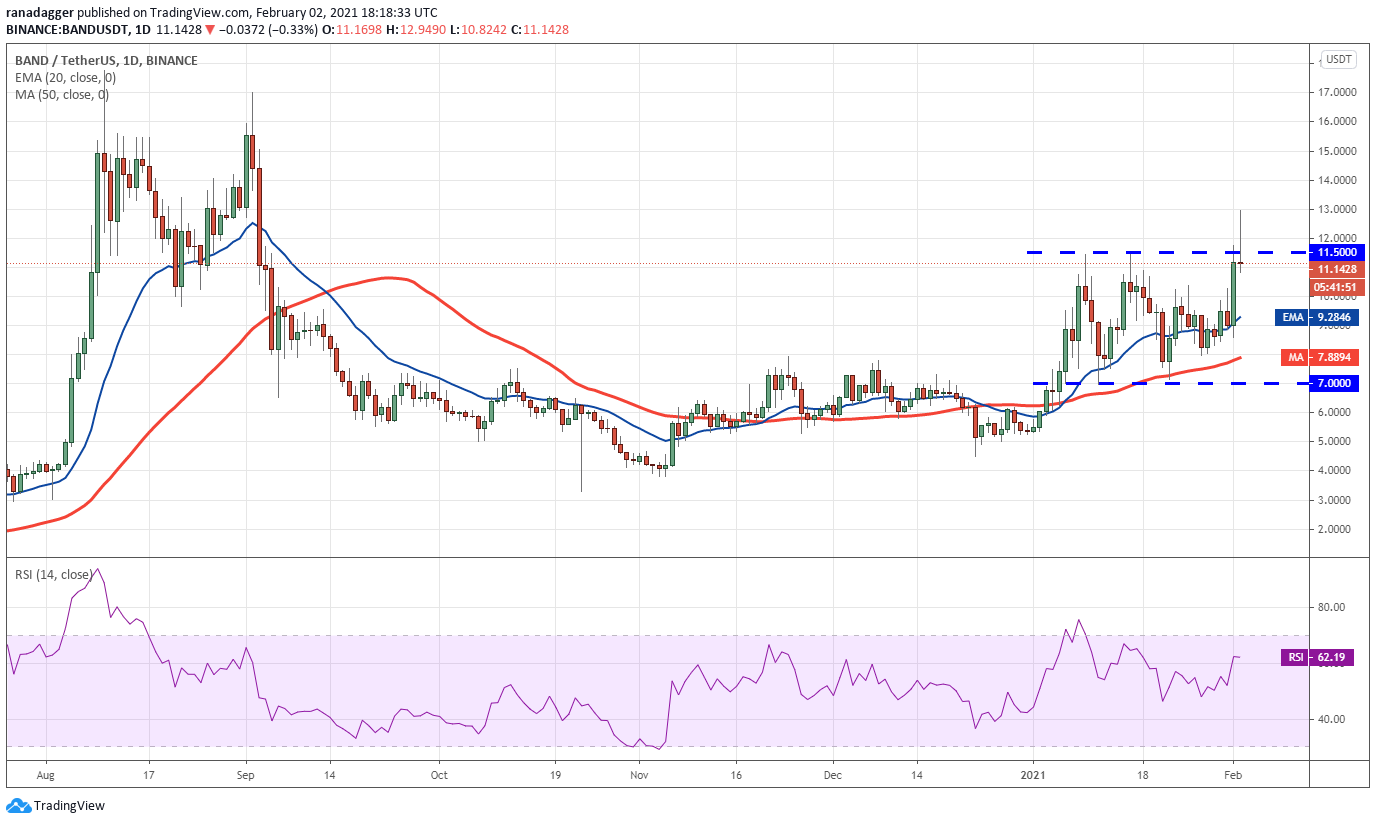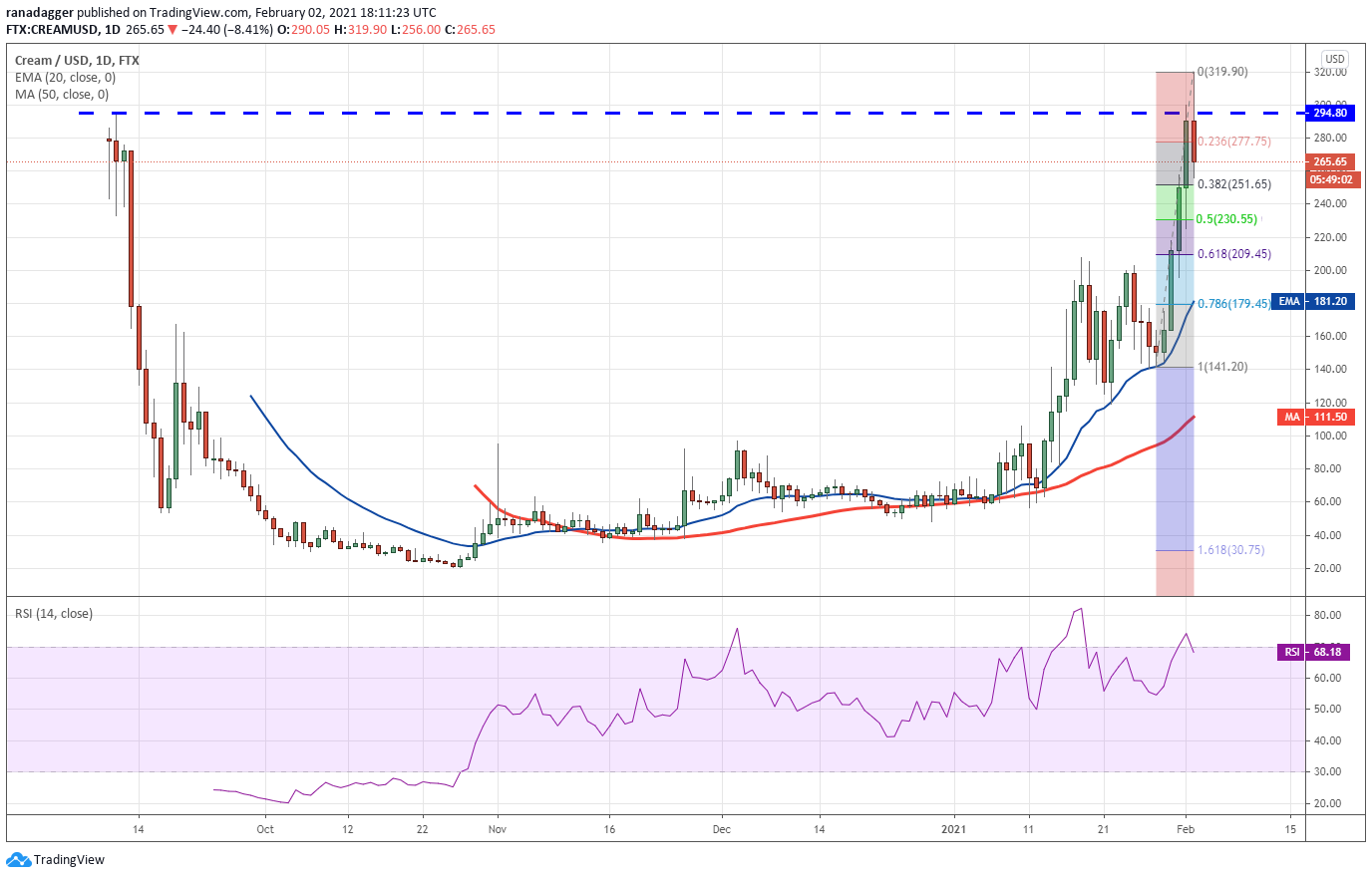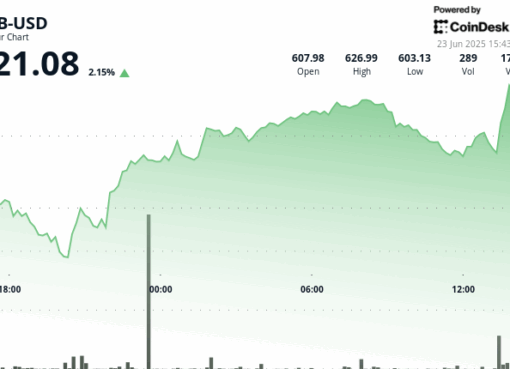The U.S. dollar lost about 7% of its value in 2020, while Bitcoin rallied about 300% during the same period. As Bitcoin’s institutional adoption increases, United States companies may start to diversify their treasury with other stores of value, and Bitcoin (BTC) stands a good chance to garner a portion of it.
Ark Invest’s latest report, “Bitcoin: Preparing for Institutions,” shows that even a paltry allocation of 1% by companies from the S&P 500 could boost Bitcoin’s price by $40,000. However, analysts at Ar believe that the allocation is likely to be in the range of 2.5% to 6.5%, which “could impact bitcoin’s price by $200,000 to $500,000.”
Even as Bitcoin’s price consolidates and readies for the next leg up, several altcoins have been rising, backed by strong fundamentals and investors’ high expectations of their upcoming products. Let’s look at three such tokens today.
BAND/USD
The decentralized finance space has boomed in the past few months, and the success of the protocols rely heavily upon data sources that are decentralized, fast and reliable. This is where Band Protocol steps in. The cross-chain data oracle has announced several partnerships in the past few days, which shows it is gradually building its market share.
The strong rally in stocks such as GameStop, AMC and others have captured traders’ attention in the past few days. Band’s tie-up with Injective Protocol to deliver decentralized price oracles for various stocks to be supported on the decentralized derivatives platform could benefit the price of its native token, BAND, as a successful integration would be followed by an increase in demand.
Similarly, Linear Finance, a derivatives asset protocol, will also use Band’s real-time price feeds to offer its clients a seamless trading experience for several synthetic assets.
Band is not limited to only providing price feeds of cryptocurrencies, foreign exchange assets and commodities. Elrond and Band have expanded their partnership further to bridge the two networks to provide off-chain data to various applications being developed on the Elrond network. Other than the usual price feeds, Band will also cater to data requests for sports, gaming, esports and much more.
Along with these, Band has also entered into partnerships with the Moonbeam protocol, Nervos and Fantom in the past few days and broadened its existing partnership with CoinGecko.
BAND price rose from $7.1532 on Jan. 22 to $12.949 on Tuesday, an 81% rally within a short time. Previous to this move, the price had largely been stuck in the range of $7 to $11.50 for the past few days.

The bulls pushed the price above the range on Tuesday, but the long wick on the day’s candlestick shows the bears are aggressively selling at higher levels. This has dragged the price back into the aforementioned trading range.
If the bulls do not give up much ground, then one more attempt to break above the range is likely. The 20-day exponential moving average ($9.28) has started to turn up, and the relative strength index (RSI) is in the positive territory, which suggests that the path of least resistance is to the upside.
If the bulls can drive and sustain the price above $11.50, the BAND/USD pair could rally to $16 and then to $17.78. This zone may act as stiff resistance, but if the bulls can propel the price above it, the momentum could further pick up.
Contrary to this assumption, if the bears successfully defend the $11.50–$12.949 resistance zone, the pair may extend its stay inside the range for a few more days.
LRC/USD
The GameStop saga and the trading limits imposed on retail traders by brokerages like Robinhood have exposed their significant flaws. This is likely to draw traders to decentralized exchanges where control does not lie with any central entity.
Transaction fees are an extremely important aspect during trading, especially for smaller-sized traders. So, when Ethereum gas fees increase, these retail traders are the most affected. Loopring attempts to solve this problem with it layer-two scaling.
Data from Dune Analytics shows that Loopring’s fee collection recently surged to its highest-ever level due to increasing volume. The protocol recently updated its LRC tokenomics model and announced a new fee distribution pattern to its various participants. This could further attract LRC investors who may want to benefit from the rising popularity of the protocol.
LRC rose from an intraday low at $0.33651 on Jan. 22 to an intraday high at $0.57618 on Jan. 31, a 71% rally within a few days. The upsloping moving averages and the RSI in the positive territory suggest that bulls are in control.

The up-move is currently facing resistance near $0.55, and the LRC/USD pair could drop to the 20-day EMA ($0.43). This is an important level to watch out for because the pair has taken support at the 20-day EMA on three previous occasions.
If the pair again rebounds off the 20-day EMA, the bulls will make one more attempt to resume the uptrend by pushing the price above $0.62167. If they succeed, the pair could rally to $0.71773 and then to $0.78.
This bullish view will invalidate if the bears sink and sustain the price below the 20-day EMA. Such a move will suggest that the bulls are not buying the dips anymore, and that could result in a fall to $0.35 and then to the 50-day simple moving average ($0.31).
CREAM/USD
Certain aspects of traditional finance could act as an inspiration to build projects in the decentralized space. Cream Finance recently announced the launch of Iron Bank, which is guided by the success of the $10-trillion U.S. corporate debt market.
While there are several peer-to-peer lending protocols existing in the crypto space, Cream has taken it a step further and created a protocol-to-protocol lending mechanism. The main attraction of the Iron Bank is that it will facilitate zero-collateral lending.
To keep the risk under check, Cream will set a credit limit after whitelisting the protocols. Initially, the Iron Bank is available only for Cream’s partners, but if this project succeeds, it is likely to be a huge positive for the entire DeFi space.
In other news, Cream recently widened its services by adding SushiSwap and Uniswap LP tokens as collateral options for lending and borrowing.
The platform’s CREAM token rallied from $119.35 on Jan. 22 to an intraday high at $319.9 on Tuesday, a 168% rally within a short time. The long wick on the day’s candlestick shows that traders aggressively booked profits at higher levels.

If the bulls do not allow the price to dip below the 38.2% Fibonacci retracement level at $251.65, it will suggest accumulation at lower levels. The upsloping 20-day EMA ($181) and the RSI near the overbought zone suggest the advantage to the bulls.
If the bulls can push and sustain the price above $294.80, the CREAM/USD pair could rally to $362 and then to $430.
Conversely, if the bears sink the price below $251.65, the pair could dip to the 61.8% retracement level at $209.45.
The views and opinions expressed here are solely those of the author and do not necessarily reflect the views of Cryptox. Every investment and trading move involves risk, you should conduct your own research when making a decision.




